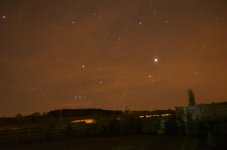actionward
Senior Member
Afternoon all,
I am starting to get good with my camera (well I think so! lol) and was away at the lakes this weekend and decided to give a try and at getting a starlight photo.
I have mixed feelings over the results, I dont seem to be able to get it right and have tried messing with the different settings. The best one I got was the one below which I think was an ISO of about 250, F3.5 and shutter speed of 15 secs. What am i doing wrong? is the orangy sky due to maybe light pollution?
I would love to hear other people ideas and see what they have maybe achieved with their cameras.
Thanks

I am starting to get good with my camera (well I think so! lol) and was away at the lakes this weekend and decided to give a try and at getting a starlight photo.
I have mixed feelings over the results, I dont seem to be able to get it right and have tried messing with the different settings. The best one I got was the one below which I think was an ISO of about 250, F3.5 and shutter speed of 15 secs. What am i doing wrong? is the orangy sky due to maybe light pollution?
I would love to hear other people ideas and see what they have maybe achieved with their cameras.
Thanks



